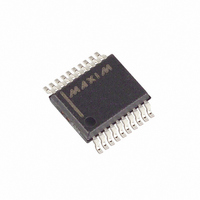MAX1142AEAP+ Maxim Integrated Products, MAX1142AEAP+ Datasheet - Page 13

MAX1142AEAP+
Manufacturer Part Number
MAX1142AEAP+
Description
IC ADC 14BIT 200KSPS 20-SSOP
Manufacturer
Maxim Integrated Products
Datasheet
1.MAX1142BEAP.pdf
(20 pages)
Specifications of MAX1142AEAP+
Number Of Bits
14
Sampling Rate (per Second)
200k
Data Interface
MICROWIRE™, QSPI™, Serial, SPI™
Number Of Converters
1
Power Dissipation (max)
640mW
Voltage Supply Source
Analog and Digital
Operating Temperature
-40°C ~ 85°C
Mounting Type
Surface Mount
Package / Case
20-SSOP
Lead Free Status / RoHS Status
Lead free / RoHS Compliant
The falling edge of CS does NOT start a conversion on
the MAX1142/MAX1143. The first logic high clocked
into DIN is interpreted as a start bit and defines the first
bit of the Control-Byte. A conversion starts on the falling
edge of SCLK, after the seventh bit of the Control-Byte
(the P1 bit) is clocked into DIN. The start bit is defined
as:
When power is first applied to the MAX1142/MAX1143
or if RST is pulsed low, the internal calibration registers
are set to their default values. The user-programmable
registers (P0, P1 and P2) are low, and the device is
configured for bipolar mode with internal clocking.
To compensate the MAX1142/MAX1143 for tempera-
ture drift and other variations, they should be periodi-
cally calibrated. After any change in ambient
temperature more than 10°C, the device should be
recalibrated. A 100mV change in supply voltage or any
change in the reference voltage should be followed by
a calibration. Calibration corrects for errors in gain, off-
set, integral nonlinearity and differential nonlinearity.
Figure 6. External Clock Mode SSTRB Detailed Timing
The first high bit clocked into DIN with CS low, any-
time the converter is idle, e.g. after AV
or as the first high bit clocked into DIN after CS is
pulsed high, then low.
If a falling edge on CS forces a start bit before the
conversion or calibration is complete, then the cur-
rent operation will be terminated and a new one
started.
SSTRB
SCLK
CS
Applications Information
______________________________________________________________________________________
14-Bit ADC, 200ksps, +5V Single-Supply
OR
t
SDV
Power-On Reset
Data Framing
Calibration
DD
is applied,
P1 CLOCKED IN
The MAX1142/MAX1143 should be calibrated after
power-up or the assertion of reset. Make sure the
power supplies and the reference voltage have fully
settled prior to initiating the calibration sequence.
Initiate calibration by setting M1 = 0 and M0 = 1 in the
Control-Byte. In internal clock mode, SSTRB goes low
at the beginning of calibration and goes high to signal
the end of calibration, approximately 80,000 clock
cycles later. In external clock mode, SSTRB goes high
at the beginning of calibration and goes low to signal
the end of calibration. Calibration should be performed
in the same clock mode as will be used for conversions
(Figure 6).
The MAX1142/MAX1143 can be used with an internal or
external reference. An external reference can be con-
nected directly at the REF pin or at the REFADJ pin.
CREF is an internal reference node and must be
bypassed with a 1µF capacitor when using either the
internal or an external reference.
When using the MAX1142/MAX1143’s internal refer-
ence, place a 0.22µF ceramic capacitor from REFADJ
to AGND and place a 2.2µF capacitor from REF to
AGND. Fine adjustments can be made to the internal
reference voltage by sinking or sourcing current at
REFADJ. The input impedance of REFADJ is nominally
9kΩ. The internal reference voltage is adjustable to
±1.5% with the circuit of Figure 7.
t
SSTRB
with Reference
t
SSTRB
Internal Reference
t
STR
Reference
13











